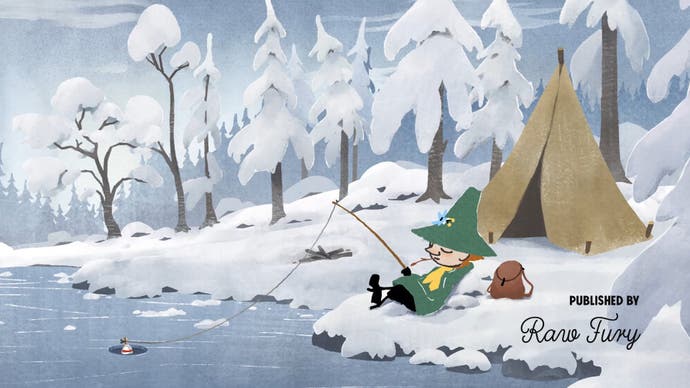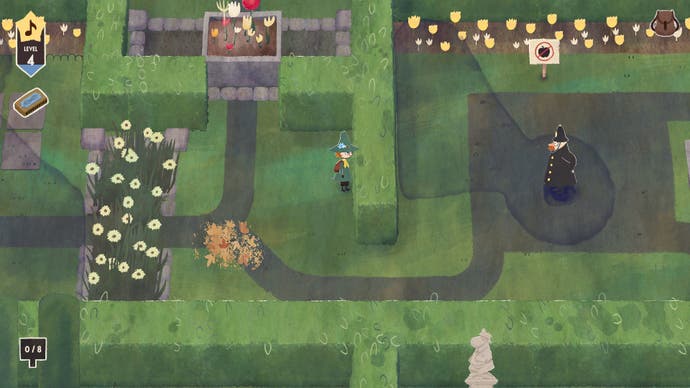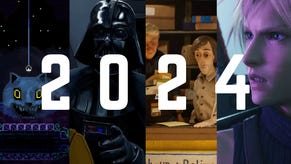Snufkin: Melody of Moominvalley review - it's just lovely
Parklife.
You can't throw a rock in Brighton without hitting a moomin. There are boutiques and galleries devoted to them. They're on our teacups and our beach towels. They're on plant pots by our windows and on the rough-papered covers of fancy Tove Jansson reprints stocking our libraries. It's not surprising that they've made it to video games, but it is surprising - to a moomin outsider, at least - to discover that the sort of thing that middle-class Southern idiots like me lap up so readily has a little bite to it. Snufkin: Melody of Moominvalley, a musical stealthy exploration game, is the best kind of surprise.
What kind of bite does the world of the moomins bring? Yesterday, I was wandering along in Moonminvalley taking Snufkin, the series' pipe-smoking philosopher, for a bit of a stroll. Beyond the rocks and trees we spied a carefully laid-out park, the shrubs suddenly cut into polite shapes, the desire paths we'd followed through scrub and long grass replaced with neat little paving slabs riddled between polite lawns. Trees suddenly had low fences around their bases. There were fences around everything, in fact, and patrolling police officers, too, or people who looked very much like it. Park officers!
This called for stealth - for muddling out patrol routes, avoiding visibility cones and sneaking from A to B. But it also called for a series of set-piece moments in which Snufkin reached a sign of some kind - a sign telling people not to loiter, or step off the path, or whatever else it is that signs tell people not to do. Whenever Snufkin reached one of these signs, he pulled them out of the ground. And once he got them all, there was a fabulous cut-scene that showed Snufkin trashing the park in general, wiping it off the surface of Mooninvalley, and returning the whole thing to a place of messy, freeform nature. What a brilliant goal for a game such as this.
Freed from the teacups and dishclothes, this is what the moomins are about, I've discovered. They seem twee, but there's the glint of steel in there. Snufkin is happy to wander, to lie against cairns and stair at the sky, but he wants nature to be nature, not tidied away and put behind barriers. A tree should be a beautiful mess. Grass should be ticklish and unruly. Reading up on this stuff a bit, I've discovered that Snufkin's suspicious of ownership in general, and even threw his own tent away in some book or another. So Melody of Mooninvalley pits him against order imposed on nature, ownership imposed on natural resources. A Park Keeper has turned Mooninvalley into their own little kingdom, and Snufkin's taking it all back.
This plays out in lovely, gentle ways, of course. The bulk of Melody of Moominvalley involves wandering through gorgeous watercolour scenes of nature, moving from glade to grotto, cliff to cave to frosty spring beachhead. Snufkin's looking for a missing friend and trying to outsmart the Park Keeper, but the game finds a place for gentle traversal stuff - hopping between stones, placing stones to hop upon, climbing rocks - and simple puzzles that often involve musical instruments. Snufkin's harmonica can win over any creatures in a circular radius, while his flute is a more targeted device, and his drum can be struck to knock things down or wake things up. A typical puzzle might have you luring a sheep-type character to a spot on a cliff, using your harmonica, so they can give you a boost up. Or maybe buzzing bees need to be sedated with blasts of the flute, or a Stalactite needs to be knocked from the roof of a grotto with a blast from the drum. Variation and playfulness, these puzzles are more about getting Snufkin to engage with the natural world than halting your progress.
Regular stealth sections in those horrible parks give things a little structure, and beyond that there's an evolving system of quests and side quests. Everything is nicely thought out, bringing a little surprise with it. A rescue quest will end up turning expectations upside down, say, while the game's map is not quite a perfect fit for the landscape it describes, meaning you still have to pay attention to the lovingly rendered wildlife around you, hunting out any bushes that might contain buzzing pieces of inspiration that allow you to level up your musical instruments - this levelling is perhaps the one part of the game that feels slightly bolted on - but which also might have a joke hiding within them, or an animal in need, or a familiar face from the books and teacups and dishclothes.



I fell into this game a bit, wandering with Snufkin over hills and crests, enjoying little details like a hammock stretched lazily between trees or a sudden vista glimpsed on the horizon, a still sea with a swollen Van Gogh moon hovering over it. Set-pieces come and go smartly and without overstaying their welcome and a middle-act switch to a new location has one of the most beautiful maps I think I have ever seen in a game.
And this. I've never read any of the Moomin books, but last year or maybe the year before I did read a memoir by Jansson about a period of her life in which she settled on a little island, Klovharun. It was "a rock in the middle of nowhere", no running water or electricity and any shelter had to be constructed. The book presents a dream landscape, but it's one of those dreams in which you have so much to do. Sorting wood and fuel and things to eat and drink: Jansson loves all this, but she doesn't hide any of it or try to frame it as something that was easy. I see that same resilience, that same fortitude, when Snufkin calmly dismantles a park and pushes back the forces of order and regulation.




